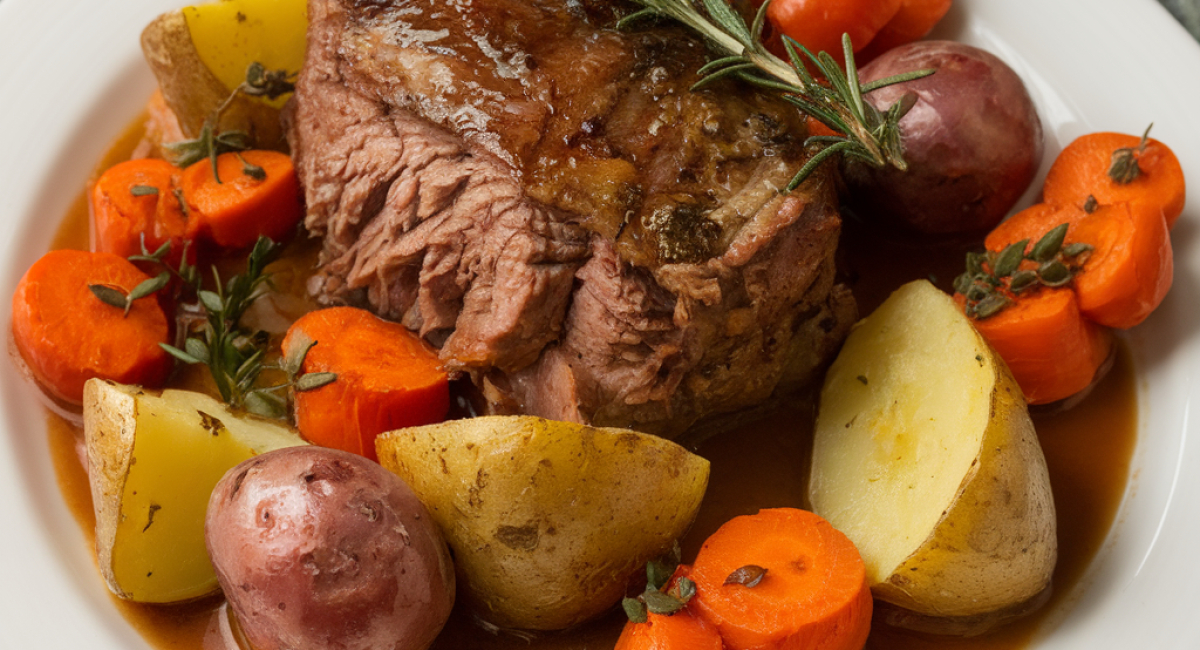Would you eat this pot roast with potatoes and carrots

Description
There's something undeniably comforting about a pot roast simmering slowly in the oven, filling the home with the tantalizing aroma of seasoned beef and fragrant herbs. This classic dish, often associated with family gatherings and Sunday dinners, has its roots deeply planted in traditional American kitchens, yet its origins can be traced back to various European cuisines. The marriage of tender beef, hearty vegetables like carrots and potatoes, and a rich, savory gravy evokes feelings of nostalgia and warmth, making it a beloved choice for many.
What makes this pot roast special isn’t just the blend of flavors but also its effortless preparation. With a few simple steps and basic ingredients, you can create a meal that transforms an ordinary evening into a cozy family feast. The beauty of a pot roast lies in its versatility; it's robust enough to impress guests while being easy enough for a casual weeknight dinner. Invite the spirit of home cooking into your kitchen as you prepare this delicious dish!
Ingredients
- 3-4 lb beef chuck roast
- 1 tablespoon olive oil
- 1 onion, diced
- 4 cloves garlic, minced
- 1 cup beef broth
- 1/2 cup red wine (optional)
- 3 large carrots, peeled and cut into large chunks
- 1 lb baby potatoes (or regular potatoes, quartered)
- 2 sprigs fresh rosemary (or 1 teaspoon dried)
- 2 sprigs fresh thyme (or 1 teaspoon dried)
- 2 bay leaves
- Salt and pepper to taste
- For the Gravy (optional):
- 2 tablespoons all-purpose flour
- 2 tablespoons butter
- Substitutions and Variations:
- If you're looking to make this pot roast more personal, consider substituting the beef chuck with a fall-apart tender brisket or a top round roast. If you want to skip the red wine, you can simply use more beef broth or even a splash of balsamic vinegar for a touch of acidity. Fresh herbs can be swapped for dried varieties; just remember that dried herbs are more potent, so use about one-third of what you'd use if they were fresh.
- For added depth, you might even throw in a couple of parsnips alongside your carrots or use sweet potatoes instead. These small tweaks can create an entirely new flavor profile while still maintaining the spirit of the dish.
Preparation Method
1. Preheat oven to 300°F (150°C).
2. Heat olive oil in a large oven-safe pot over medium-high heat.
3. Season the chuck roast with salt and pepper on all sides.
4. Sear the roast in the pot for 3-4 minutes on each side until browned, then remove and set aside.
5. Sauté diced onion and minced garlic in the same pot for 2-3 minutes until translucent.
6. Deglaze the pot with red wine and beef broth, scraping the bottom for flavor.
7. Add carrot chunks, potatoes, and herbs to the pot.
8. Return the seared roast to the pot, cover, and transfer to the oven.
9. Cook for 3-4 hours until tender, checking for an internal temperature of 190°F (88°C).
10. Remove the pot from the oven and let the roast rest for 15-20 minutes.
11. For optional gravy, strain the cooking liquid into a measuring cup.
12. Melt butter in a small saucepan, whisk in flour to make a roux.
13. Gradually add the reserved cooking liquid while whisking until smooth and thickened.
14. Taste and adjust seasoning with salt and pepper.
Tips and Conclusion
For a delightful side dish that pairs perfectly with your pot roast, consider serving a simple green salad drizzled with a light vinaigrette. The freshness of the salad will beautifully balance the richness of the roast. Alternatively, creamy mashed potatoes or buttery cornbread are also excellent options that complement the flavors of this hearty dish.
If you're preparing this roast for meal prep, it stores wonderfully in the refrigerator for up to 3 days, and it actually tastes even better the next day as the flavors continue to meld. Simply reheat gently in a saucepan over low heat. You can also freeze individual portions for a cozy meal on a chilly day; just make sure to store the gravy separately to retain its texture.
As you gather around the table with loved ones, savoring the tenderness of the pot roast infused with fragrant herbs and the sweet earthiness of perfectly cooked vegetables, you’ll appreciate the time and effort you invested in creating this hearty meal. Preparing a pot roast is more than just following a recipe; it’s about bringing people together and enjoying the simple pleasures of home-cooked food.
Don’t let this be the end of your culinary journey here! Explore other comforting recipes, such as savory beef stew or creamy chicken pot pie, to continue delighting your palate. Consider sharing your pot roast experience at the table and encouraging others to try it—home cooking doesn’t just nourish the body; it nurtures the soul. Enjoy, and happy cooking!







